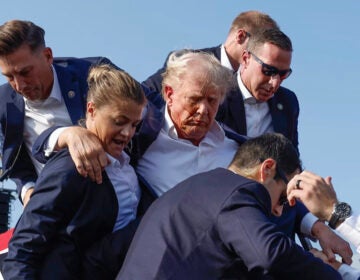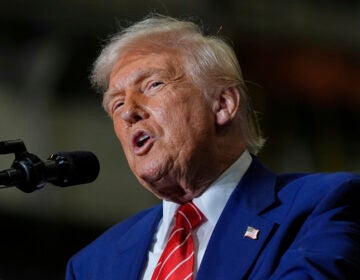Executive orders are business as usual; Trump’s White House no exception
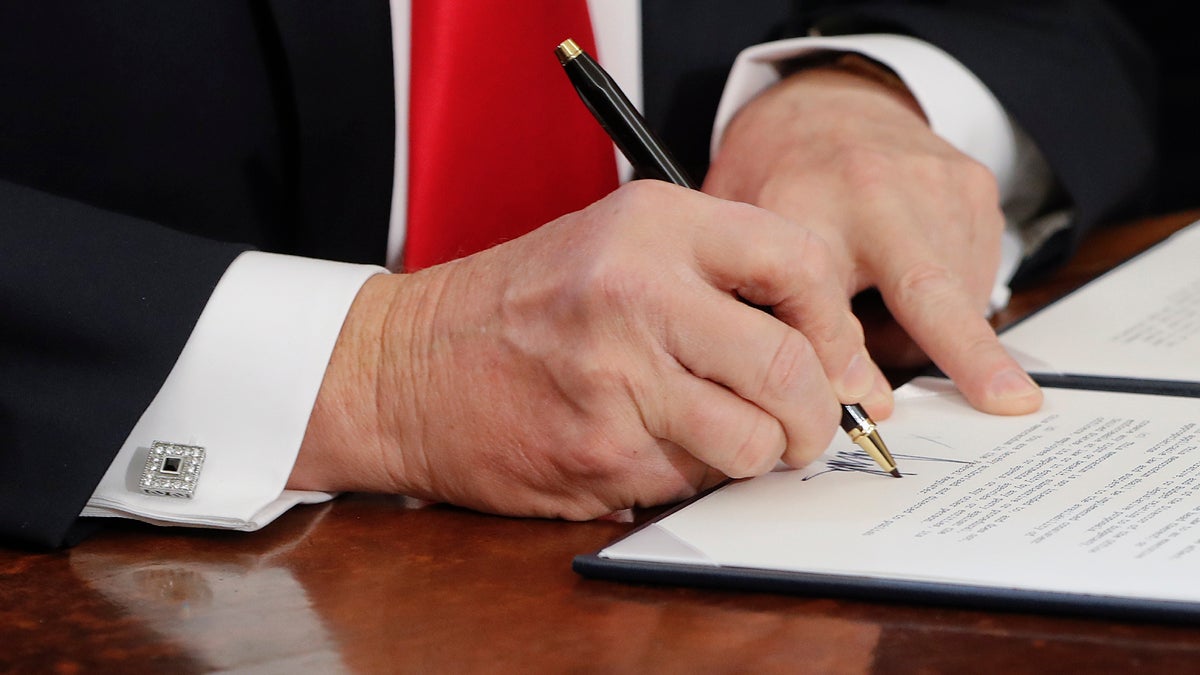
In this Feb. 3, 2017, photo, President Donald Trump signs an executive order in the Oval Office of the White House in Washington. Reality took a beating from the Washington blame game this past week. Americans heard about a Kentucky massacre that never happened, a travel ban that was a ban despite it being called something else, and a dark plot to help Russian intelligence that was nothing of the sort. (AP Photo/Pablo Martinez Monsivais)
In the two weeks since Donald Trump was sworn into office, executive orders have been his bread and butter, like many presidents before him. He’s averaging one per day, and he’s dominating the news cycle with them.
But historically speaking, 18 unilateral policy changes (seven orders and 11 presidential memorandums) in two weeks isn’t particularly groundbreaking.
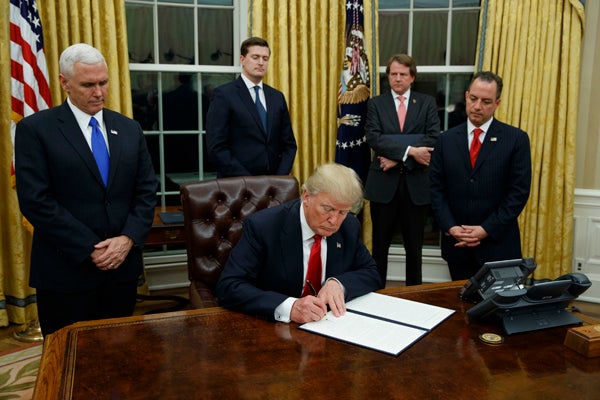 President Donald Trump, flanked by Vice President Mike Pence and Chief of Staff Reince Priebus, is shown on Jan. 20, 2017, signing his first executive order on health care in the Oval Office of the White House in Washington. After years of objecting to President Barack Obama’s use of executive power to work around Congress, President Donald Trump and Republicans allies have all-but abandoned their public complaints about checks-and-balances and embraced the go-it-alone strategy to fast-track their dismantling of Obama’s policies. (Evan Vucci/AP Photo, File)
President Donald Trump, flanked by Vice President Mike Pence and Chief of Staff Reince Priebus, is shown on Jan. 20, 2017, signing his first executive order on health care in the Oval Office of the White House in Washington. After years of objecting to President Barack Obama’s use of executive power to work around Congress, President Donald Trump and Republicans allies have all-but abandoned their public complaints about checks-and-balances and embraced the go-it-alone strategy to fast-track their dismantling of Obama’s policies. (Evan Vucci/AP Photo, File)
Michael Gerhardt, a scholar in residence at the National Constitution Center, wasn’t surprised. This is normal when the White House shifts in control, because with it comes policy change, he said.
Executive Orders by the numbersCreate your own infographics
Barack Obama enacted 20 executive orders in his first two weeks in office, but very few in 2012 when he was re-elected. In short, executive orders are a staple of new administrations.
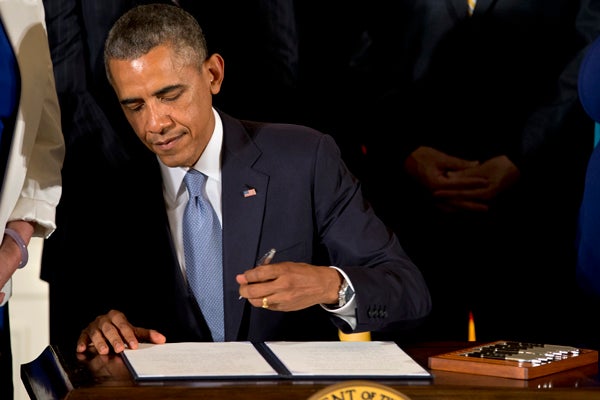 President Barack Obama is shown on July 21, 2014, signing executive orders to protect LGBT employees from federal workplace discrimination in the East Room of the White House. (Jacquelyn Martin/AP Photo, File)
President Barack Obama is shown on July 21, 2014, signing executive orders to protect LGBT employees from federal workplace discrimination in the East Room of the White House. (Jacquelyn Martin/AP Photo, File)
“These executive orders have sparked more than usual attention for a couple reasons,” Gerhardt said. “They’ve been framed a certain way. Their language has grabbed more media attention and public attention. Usually, they are just dry legal documents.”
As is the case with many presidents throughout history, Trump entered the world stage at a time that may seem pivotal, Gerhardt said. But it’s not like we haven’t seen conflict before, he said.
Take Franklin Roosevelt. When he was elected in 1933, the country was in crisis: 13 million unemployed, banks shuttering, economic disaster looming. Roosevelt famously promised change in the first 100 days of his presidency, proposing the “New Deal,” that would temporarily help struggling, unemployed Americans. Sounds familiar.
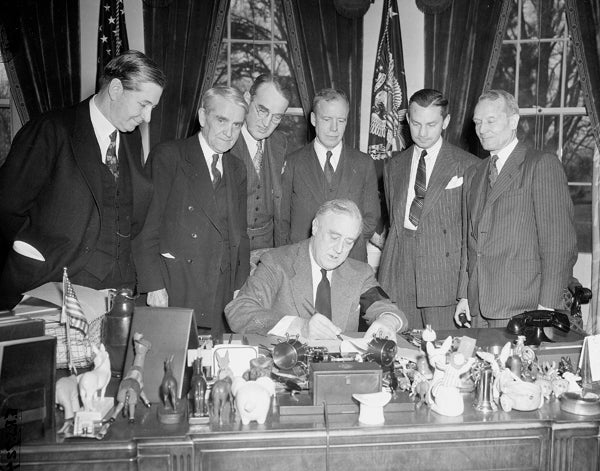 President Franklin Roosevelt is shown on March 26, 1942, signing an executive order authorizing the financing of war contracts through guaranteed loans. Standing behind Roosevelt are, from left: Senator James E. Murray, D-Mont; Senator Arthur Capper, R-Kas; Senator James M. Mead, D-NY; Assistant Secretary of War Robert P. Patterson; Under Secretary of Navy James V. Forbes, and Rear Admiral Emory S. Land, U.S. Wartime Commission. (AP Photo)
President Franklin Roosevelt is shown on March 26, 1942, signing an executive order authorizing the financing of war contracts through guaranteed loans. Standing behind Roosevelt are, from left: Senator James E. Murray, D-Mont; Senator Arthur Capper, R-Kas; Senator James M. Mead, D-NY; Assistant Secretary of War Robert P. Patterson; Under Secretary of Navy James V. Forbes, and Rear Admiral Emory S. Land, U.S. Wartime Commission. (AP Photo)
“I think Republicans were miffed over the election and they cast Roosevelt in negative terms,” Gerhardt said. “There was pretty stiff opposition. It’s hard to compare Trump with Roosevelt … but we have presidents like Roosevelt and Hoover who try hard at the beginning to do something significant, and that’s going to stir up controversy.”
Roosevelt signed only one executive order in his first two weeks in office. But on average, he signed 307 per year, according to the Pew Research Center. And those orders were to the dismay of his Republican enemies, Gerhardt said.
According to that same study, it was under Roosevelt that 3,721 executive orders were issued (although this was spread across four terms). But Roosevelt signed 573 of those orders in his first year in the White House.
Roosevelt signified a spike in this kind of unilateral action — before him Hoover, Harding, Wilson, Taft, and Theodore Roosevelt all signed more than 500 orders each.
Pew also concluded that Obama, George W. Bush, and Clinton used executive orders to make changes related to government commissions, boards or committees, as well as changes to government agencies and employees most frequently.
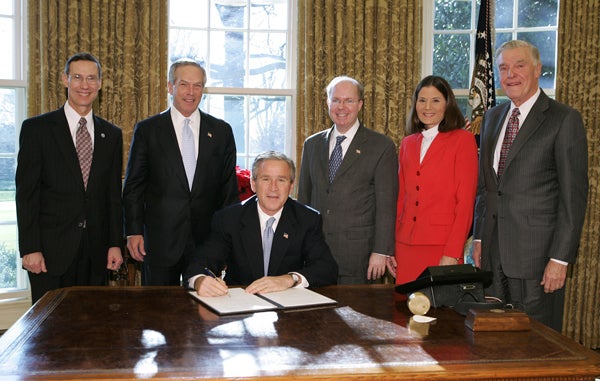 President George W. Bush is shown on Dec. 17, 2004, signing an executive order on the establishment of the Committee on Ocean Policy in the Oval Office at the White House. Attending the signing from left to right: Vice Admiral Conrad Lautenbacher, Jr., Undersecretary of Commerce for Oceans and Atmosphere and Administrator for the National Oceanic and Atmospheric Administration; Commerce Secretary Donald Evans, Chairman Jim Connaughton, Council on Environmental Quality; Assistant Secretary of Policy, Management, and Budget, Dept. of the Interior, Lynn Scarlett and Admiral James D. Watkins, Chairman, U.S. Commission on Ocean Policy. (Paul Morse/AP Photo/White House)
President George W. Bush is shown on Dec. 17, 2004, signing an executive order on the establishment of the Committee on Ocean Policy in the Oval Office at the White House. Attending the signing from left to right: Vice Admiral Conrad Lautenbacher, Jr., Undersecretary of Commerce for Oceans and Atmosphere and Administrator for the National Oceanic and Atmospheric Administration; Commerce Secretary Donald Evans, Chairman Jim Connaughton, Council on Environmental Quality; Assistant Secretary of Policy, Management, and Budget, Dept. of the Interior, Lynn Scarlett and Admiral James D. Watkins, Chairman, U.S. Commission on Ocean Policy. (Paul Morse/AP Photo/White House)
So far, this has not been the case for President Trump. His orders have sparked controversy because of their brashness, and even constitutionality, some say. (Although his immigration-restricting order imposed last week has been put on hold by a Washington state judge).
But Trump doesn’t stand alone in creating public outrage.
The Emancipation Proclamation was an executive order, as was the order that allowed military leaders to remove Japanese-Americans from their homes and into internment camps.
To read the executive orders and memos Trump has signed so far, or any he will sign in the future, visit the archives of the Office of the Federal Register.
WHYY is your source for fact-based, in-depth journalism and information. As a nonprofit organization, we rely on financial support from readers like you. Please give today.


